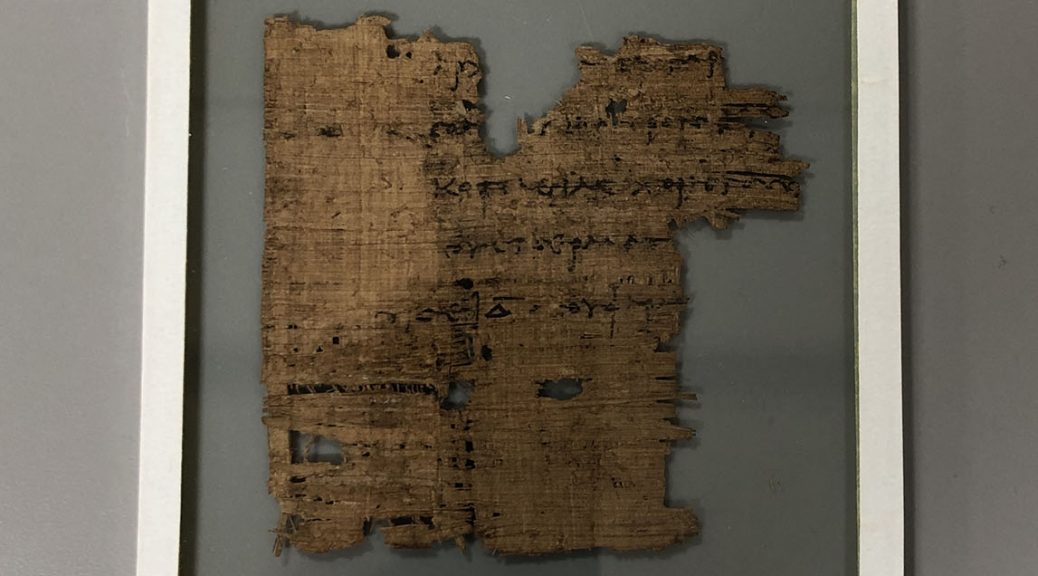Quite a bit has been written on this blog over the years about caring for Duke’s sizable papyri collection, so many of our readers will be familiar. For those who may not know about it, the collection was digitally imaged back in the early 1990s and the images are publicly available for research. The Duke Papyrus Archive is a very helpful and well-used resource, but sometimes we get requests to reimage fragments from the collection. It may be that the resolution of the images in the archive is too low for a researcher’s needs, or there is a request to use multispectral imaging to see if additional information can be made legible.

As we have mentioned before, each papyrus fragment is stored between two pieces of glass, which are taped around the edges. This housing solution allows the extremely fragile fragments to be safely and easily handled in the reading room, but it does pose some challenges for imaging. Our digital production staff are able to adjust the lighting environment to reduce reflections from the glass, but the glazing package also needs to be very clean both inside and out. Any dust, stray fibers, or residue are clearly visible in the high resolution images we produce. Prior to reimaging, each fragment is examined to determine if any cleaning or additional intervention is required.
Some of the taping on the glass packages is starting to show some wear and tear. White paper tape was used to seal the glazing for many of the fragments and the adhesive may have become desiccated and failed, or the paper carrier may be splitting. Sharp glass corners or edges may also be untaped and exposed.
 Re-imaging is a good opportunity to remove the fragment from its glazing, clean the package, remount the fragment, and reseal the package with higher quality materials. The process is pretty straightforward. To begin, the tape is sliced open on all edges with a scalpel and the top piece of glass is carefully lifted away.
Re-imaging is a good opportunity to remove the fragment from its glazing, clean the package, remount the fragment, and reseal the package with higher quality materials. The process is pretty straightforward. To begin, the tape is sliced open on all edges with a scalpel and the top piece of glass is carefully lifted away.
 Next the papyrus fragment is removed by very gently sliding it off of the bottom glass sheet onto a piece of clean Bristol board. The surface of the board is very smooth, so papyrus fibers along the edge of the fragments do not catch. The fragment may actually be composed of several loose pieces, so I always do a few little test lifts at the edges of the piece with a microspatula first to get a sense of the fragment’s condition. Luckily, this fragment is all in one piece. I like to note the orientation of the fragment in pencil at the corner of the board, just as a reminder when I go to reassemble the package. The fragment is placed in a temporary enclosure for safety and set aside.
Next the papyrus fragment is removed by very gently sliding it off of the bottom glass sheet onto a piece of clean Bristol board. The surface of the board is very smooth, so papyrus fibers along the edge of the fragments do not catch. The fragment may actually be composed of several loose pieces, so I always do a few little test lifts at the edges of the piece with a microspatula first to get a sense of the fragment’s condition. Luckily, this fragment is all in one piece. I like to note the orientation of the fragment in pencil at the corner of the board, just as a reminder when I go to reassemble the package. The fragment is placed in a temporary enclosure for safety and set aside.
The adhesive of the paper tape is water-soluble and comes off of the glass pretty easily. After mechanically scraping off the tape carrier with a scalpel blade, the glass is placed in small plastic tray filled with filtered water so that any remaining residue will soften and can be scrubbed off. I finish cleaning the glass with a 1:1 ethanol and deionized water solution and buff the surface with a cotton pad. To keep it as clean as possible it’s important to clean any working surfaces beforehand and wear gloves.

With the glass clean and dry, it’s time to transfer the papyrus fragment back. The papyrus fragment is aligned on the lower glass and secured to it using very small pieces of pre-made remoistenable repair tissue (see Baker 2010 for instructions on making the remoistenable paper). When the mounting strips are dry, the upper sheet of glass is placed on top and the edges are taped with Filmoplast SH linen tape. I like to double-up the taping at the corners of the package to ensure that every edge is completely covered.
 In the years before the Rubenstein Library renovation, these glass packages were rehoused in uniform rigid portfolios with cut foam padding. Each portfolio has a picture label and small groups of them are stored together in metal edge boxes for easy retrieval. You can see images and read about that rehousing project here. These portfolios are still functioning very well, so the cleaned and retaped glazing package is placed back in it’s custom portfolio and box before being transferred to the digital production center.
In the years before the Rubenstein Library renovation, these glass packages were rehoused in uniform rigid portfolios with cut foam padding. Each portfolio has a picture label and small groups of them are stored together in metal edge boxes for easy retrieval. You can see images and read about that rehousing project here. These portfolios are still functioning very well, so the cleaned and retaped glazing package is placed back in it’s custom portfolio and box before being transferred to the digital production center.


